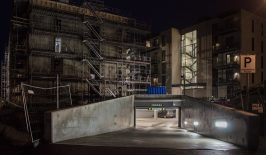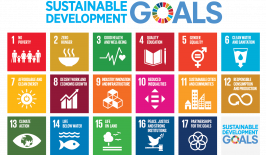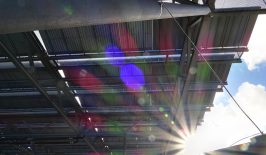A ground-breaking construction project is scheduled to start on the southern outskirts of Copenhagen by the end of this year: the UN17 Village. The plan is to build a 35,000 metre square residential area for around 830 inhabitants – and in it, address all 17 of the UN’s Sustainable Development Goals, with a particular focus on sustainable resources use and healthy, social communities. Architect Anders Lendager and the Lendager Group are behind the project, having won a competition last year to see who would be chosen to construct the new developments in the Ørestad South area of the city. According to the current schedule, five blocks of about 400 apartments are to be built by 2023. By prioritizing the 17 SDGs, Anders Lendager aims to set new standards for sustainable building and create construction methods that can be adopted by projects of all different sizes in the future.
According to Anders Lendager, the UN17 Village is designed to be sustainable “from multiple perspectives.” During the construction phase, the choice of building materials is key when it comes to ensuring sustainability. Here, Lendager aims to focus on upcycling materials that have traditionally been discarded, and thought of waste. They’ll be using the services of the company’s subsidiaries, Lendager UP, a company which is dedicated exclusively to the production of new and innovative upcycled building materials – using them on an industrial scale in order to reduce the environmental impact of the construction industry. They source construction waste – concrete, plastic, wood and glass – process it and reuse it to make floors, ceilings and windows.
In order to achieve the goal of affordable and clean energy, the UN 17 village will produce its own renewables and be completely energy self-sufficient. A 200-metre-deep vertical drilling rig will form the basis of the heating and cooling systems powered by geothermal energy and solar systems will also be installed. The buildings are designed to limit energy consumption and to produce and recycle energy. According to the plan, some of the buildings will even produce more energy than they need, with the excess then being strategically distributed to other areas of the site.
Water will be provided via an independent water recycling system. The aim is to recycle 1.5 million litres of water annually through the treatment of rainwater, the double use of waste water for toilets and the purification and reuse of water from swimming areas.
Everyday life in the world’s most sustainable settlement
Anders Lendagers believes that new construction projects should “support the natural biodiversity of the area”. That’s why, in addition to the buildings, the UN17 Village will also include large green areas that are adapted to the local flora and fauna. Balcony gardens, kitchens with natural elements and rooftop gardens are also in the planning. The architect’s goal is the “sustainable use of terrestrial ecosystems”.
In order to promote and enable a healthy community, fruit and vegetables are to be grown in greenhouses and roof gardens. The products will then be used directly within the village restaurants in order to reduce emissions from the transportation of food. In total, they predict they’ll be able to grow enough food for 30,000 meals per year. They also want to promote the concept of food sharing – distributing leftover food to those who need it.
Social factors also play a key role in the planners’ vision. One key goal is to reduce inequality by “accommodating multi generations, sexes and genders and generally offer a very high social diversity”, as Lendager explains. About 175 children and 100 older residents are set to be housed in the different buildings. Local restaurants and a conference centre sustainability-related events will create an additional 100 new jobs, designed primarily to go to unskilled and marginalised workers.
Lendager’s vision with the UN17 Village is to create a housing development that proves that sustainable construction is possible. He hopes that by providing transparency during the planning phase and organising conferences about it after the project is completed, he will be able motivate others in the industry to follow his lead – ultimately turning UN 17 into “the first benchmark of how we think we should be building in the future.”









